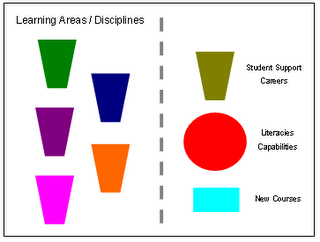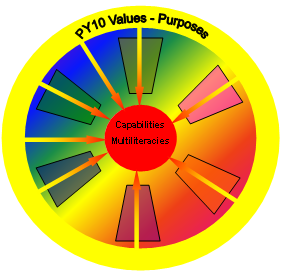Knowledge and Slowness in Learning
Knowledge workers need to know how to use
tools and frameworks to do their jobs according to Charles Jennings, Global Head of Learning at Reuters UK. Jennings painted a clear picture of the way workplaces have changed over the last 20 years on day 2 of the
Global Summit 2006 in Sydney:
- 70% of jobs created in the USA since 1998 have been for "knowledge workers"
- "knowledge worker"jobs now make up 41% of all jobs in the USA (2005)
- only 20-30% of workplace performance is knowledge/skills related (2005)
- people learn 80% of what they need to know informally on-the-job
He cited Kelley's longitudinal study showing how the amount of knowledge that we need to know in our own minds to do our jobs has changed: 1986 - 75% ... 1997 - 15-20% ... 2006 - 8-10%
Jennings spoke of the need to shift from training to learning; of the need to know less and learn more; of the need for workers to have tools and frameworks to locate and process what they need to know when they need to know it.
And now for something completely different...
Geetha Narayanan from the School of Art Design and Technology, India presented two concepts. The first was the importance of digital story telling - showing how young disadvantaged people can be empowered to use cameras and recorders to tell their own powerful stories. And to tell them so well that they win international competitions.
 The second was the notion of "slow schools". Narayanan spoke of the importance of health and well-being among today's technology rich, fast-paced and consumer oriented middle-class learners. The slow school idea was spawned by the slow food campaign which began as a protest against fast-food outlets but is rapidly becoming a global movement and has recently been popularised by TV chef Jamie Oliver as slow food moves into schools and begins to transform education...
The second was the notion of "slow schools". Narayanan spoke of the importance of health and well-being among today's technology rich, fast-paced and consumer oriented middle-class learners. The slow school idea was spawned by the slow food campaign which began as a protest against fast-food outlets but is rapidly becoming a global movement and has recently been popularised by TV chef Jamie Oliver as slow food moves into schools and begins to transform education...
Slow schools look for opportunities to slow the pace of thinking and move to being in the moment. Narayanan gave examples of moving students from thinking about the sun to embodying and being the sun as they sit in circles with feet touching, or slowly draw 10 suns rather than one, or as they dance watching sunrise...
Slow schools allow time for discussion and reflection - and focus on how students form concepts and make meaning.
 Co-incidentally my blog reading recently introduced me to "slow design" and "slow cities" - the latter is already a network of 100 towns in 10 countries embodying the 'slow' metaphor.
Co-incidentally my blog reading recently introduced me to "slow design" and "slow cities" - the latter is already a network of 100 towns in 10 countries embodying the 'slow' metaphor.
Perhaps this brings new meaning to the concept of the slow learner :-)
Labels: 21stCentury, conceptual frameworks, transformation
Can Schools Save the Planet?

If politicians are talking about global warming it must be VERY serious according to Robert Cailliau, a co-inventor of the world-wide-web, who spoke at the
Global Summit 2006 yesterday.
Cailliau suggests that educators need to consider the role of education in addressing some of the most challenging issues that face the planet today. But how? What knowledge, skills, understanding, apptitudes... will help learners to help the planet?
Einstein reminded us that you can't solve problems with the same kind of thinking that created them. What kind of thinking do we need in educational institutions and how will it be different?
We can talk about engaging and empowering students to be active learners and global citizens in a technology connected world but what about different ways of thinking?
Is it about looking at principles of sustainability and social justice such as those expressed in
The Earth Charter ?
Is it about the knowledge and skills and understanding of futures thinking and
social foresight?
Is it about challenging our
assumptions and worldviews and using more
holistic or
integral ways knowing and being?
If we don't "think differently" how as
James Boscoe asked delegated do we know we won't be sitting at conferences in 20 years time asking ourselves the same questions? Or perhaps we won't have the luxury of being able to sit in conference buildings... at least where they are built now anyway...
Labels: sustainability, transformation
Designing Courses: Learning Areas and Capabilities
I've been playing with models that might clarify the process of designing courses in order to provide for
all students under the new Post Year 10 Curriculum Framework for Tasmania. I've also been reading about the
current call for a "back to basics" national curriculum and in particular thinking about
Alan Reid's proposal's in
Rethinking National Curriculum Collaboration - but within a State rather than national context.
(School education is the constitutional responsibility of the States in Australia.)Before the current PY10 Curriculum Framework was developed the structure of the curriculum was hard to conceptualise. In the late 80s and early 90s traditional subjects were loosely grouped into 'learning areas'; new programs to support literacy, numeracy and ICT literacy were developed; new courses emerged and some stayed; student support, health and well-being and career/pathway options evolved; key competencies/capabilities were identified...

However much of this sat outside traditional subjects/leaning areas - conceptually and often in implementation as well - or sometimes uneasily within syllabuses and timetables as attempts were made to "embed them".
Syllabus development most often occurred within subject/learning areas and tended to reinforce existing knowledge structures, ways of learning, teaching and assessment. New courses often failed to gain a foothold if they did not fall neatly into traditional ways of organising knowledge.
The new PY10 Curriculum Framework is based on agreed values and purposes arrived at during a long period of co-construction. We are currently looking at the structures and processes that might inform the provision of courses within the Framework. What range of courses will be available to choose from?
While we now have a State Curriculum Framework individual year 11/12 schools will be responsible for implementation to meet student needs in local contexts. Which courses will schools choose to offer their students? And how will individual classroom teachers interpret these courses?

(NB In this graphic the number of learning areas is arbitrary.)
A key question at the moment is what sits between the values and purposes and the capabilities/literacies? What are the contexts for learning? Can we move away from learning areas? Should we move away from learning areas? Following Reid's suggestion (in the above paper) can we develop courses where students learn for the capabilities through the learning areas - leaving the details of what learning to schools, teachers and students?

Or will existing ways organising knowledge/skills and their associated communities of practice work against providing opportunities to develop all the capabilities required for the 21st century? Will anything really change if traditional learning areas still dominate structures and processes for course/syllabus development.
And where do transdisciplinary approaches fit? How do we move beyond disciplines to engage in the kind of rigorous thinking that is needed to meet today's societal and planetary challenges? Can we construct valued learning experiences/courses that exist in the space between the disciplines and their well developed resources/support structures/dialogues?

Perhaps we need to use other lenses/conceptual frameworks to help us create courses/learning experiences that help students to make meaningful connections beyond subject borders and to "know what they don’t know". Can we generate meaningful content/contexts by asking the big questions? Is an 'integral' lens useful as a conceptual framework?

Perhaps course developers and classroom teachers (hopefully the same people) need to draw on a course development toolbox containing a variety of conceptual lenses... A learning ecology/connectivism framework such as the following by George Siemens that looks at "know where" as well as "know-how" and "know-what" might be one tool.

And how can we establish course developement models/principles that ensure the ongoing currency of courses in today's rapidly changing world?
Labels: 21stCentury, conceptual frameworks, curriculum, learning, literacies, transdisciplinary
 The second was the notion of "slow schools". Narayanan spoke of the importance of health and well-being among today's technology rich, fast-paced and consumer oriented middle-class learners. The slow school idea was spawned by the slow food campaign which began as a protest against fast-food outlets but is rapidly becoming a global movement and has recently been popularised by TV chef Jamie Oliver as slow food moves into schools and begins to transform education...
The second was the notion of "slow schools". Narayanan spoke of the importance of health and well-being among today's technology rich, fast-paced and consumer oriented middle-class learners. The slow school idea was spawned by the slow food campaign which began as a protest against fast-food outlets but is rapidly becoming a global movement and has recently been popularised by TV chef Jamie Oliver as slow food moves into schools and begins to transform education... Co-incidentally my blog reading recently introduced me to "slow design" and "slow cities" - the latter is already a network of 100 towns in 10 countries embodying the 'slow' metaphor.
Co-incidentally my blog reading recently introduced me to "slow design" and "slow cities" - the latter is already a network of 100 towns in 10 countries embodying the 'slow' metaphor.









